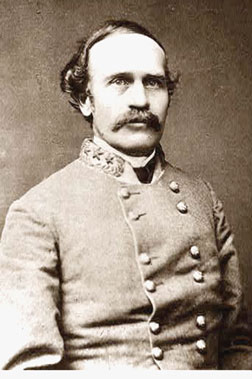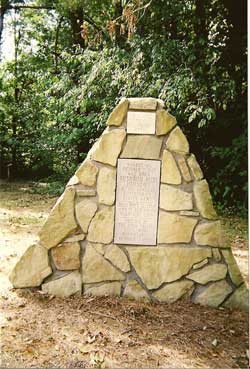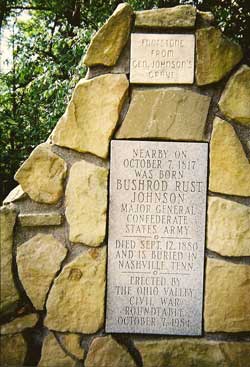At this point in his career, Johnson made a
serious mistake in judgment and approached
his commanding officer in New Orleans with a
scheme to make money by misappropriating
government property. That officer turned him
in. A government inquiry followed and the
decision was appealed to then President
James K. Polk. Johnson was allowed to resign
his commission in October 1847 without
prosecution.
His career in the U.S. Army was over.
Johnson put his West Point education and
military experience to use and landed a job
teaching at Western Military Institute in
Georgetown, Ky. James G. Blaine, future
speaker of the U.S. House of Representatives
and presidential candidate, was an
instructor there.
Eventually, Johnson became headmaster. He
married Mary Hatch. They had a son, Charles,
who was an invalid and required continual
care. Mary died of “nervous fever” in 1858.
Johnson hired a nanny and continued to
teach. In 1855, WMI moved to Nashville where
it merged with the University of Nashville.
WMI continued as a prep school offering high
school instruction.
Smyrna’s Sam Davis, “Boy Hero of the
Confederacy,” attended the Western Military
Institute from 1860 to 1861 and was a
student of Bushrod Johnson.
The WMI campus was located from 1855 to 1861
at 724 Second Avenue South, which serves
today as Metropolitan Nashville City
Government's Planning Building.
Designed by architect Adolphus Heiman, it is
the only remaining structure of the original
University of Nashville. The two-story
limestone structure is Gothic Revival in
style with buttresses and a castle-style
parapet. During the Civil War the occupying
Federal forces used the building as Hospital
No. 2, housing 300 beds. From 1944 to 1973
the building served as the Children's
Museum.
By the outbreak of the Civil War, Johnson
was a prominent Nashville citizen, who sided
with the causes of the Confederacy. He was
appointed colonel and chief of engineers of
the Provisional Army of Tennessee. On Jan.
25, 1862, Johnson was made a brigadier
general in the Confederate Army. His son,
Charles, was sent north and relatives in
Ohio cared for him during the War.
Johnson quickly amassed a commendable combat
record.
His actions at Fort Donelson were one of the
few bright spots for Confederate defenders
as he led the Rebel’s left flank in a
successful assault on the Union right.
During the Battle of Shiloh he led his own
Tennessee brigade in heavy action. His
brigade suffered 740 casualties at Shiloh,
and an exploding shell killed Johnson’s
horse.
Johnson’s Brigade was comprised of the 17th,
23rd, 25th, 37th and 44th Tennessee Infantry
regiments and the Jefferson Artillery from
Mississippi.
At Perryville, Ky., Johnson led his men in
the assault across Doctor’s Creek on Oct. 8,
1862 and had five horses shot out from under
him in the Confederate’s 1862 Kentucky
Campaign.
Following a “technical victory” at
Perryville, Gen. Braxton Bragg, commanding
what was known then as the Army of
Mississippi, withdrew his army to
Murfreesboro where it was reformed as the
Army of Tennessee. With the Confederate
troops moving out, Kentucky was to remain
under Union control for the rest of the war,
an important strategic victory for the Union
and particularly for Kentucky-born Abraham
Lincoln.
Bragg's Army of Mississippi consisted of
about 16,800 men in two wings. The Right
Wing, commanded by Maj. Gen. Leonidas Polk,
consisted of a single division under Maj.
Gen. Benjamin F. Cheatham. The Left Wing,
commanded by Maj. Gen. William J. Hardee,
consisted of the divisions of Brig. Gen. J.
Patton Anderson and Maj. Gen. Simon B.
Buckner. Johnson’s Brigade was assigned to
Buckner.
As 1862 drew to a close the Confederate Army
of Mississippi merged in Murfreesboro with
the Army of Kentucky forming the Army of
Tennessee.
Bushrod Johnson’s Brigade was assigned to
the 2nd Division of Hardee’s Corps. Maj.
Gen. Patrick Cleburne was division
commander.
Again at Stones River on Dec. 31, 1862,
Johnson’s troops were in the thick of the
fight with Cleburne’s Division pushing the
Federal line back three miles. Following a
strong resistance led by Union Brig. Gen.
Phil Sheridan, Johnson rallied his troops
and held the line. His men suffered more
than 600 casualties and captured two Federal
batteries.
At Hoover’s Gap on June 24, 1863, Johnson’s
Brigade was among the first to taste the
bitter firepower of the Spencer repeating
rifles wielded by Union Col. John T.
Wilder’s Brigade. Johnson’s Brigade joined
Brig. Gen. William B. Bate’s Brigade in an
attempt to dislodge Wilder from the narrow
gap but failed.
The Battle of Chickamauga on Sept. 30, 1863,
was the highpoint for Johnson and his men.
Johnson was promoted to provisional division
command with his brigade combined with those
of Brig. Gens. Evander McNair and John
Gregg. Johnson’s command was in the center
of the Confederate left that slammed through
a quarter-mile gap left in the Federal line
by Maj. Gen. Thomas Wood's withdrawal.
Johnson wrote about the moment:
“The scene now presented I was unspeakably
grand. The resolute and impetuous charge
sweeping out of the shadow and gloom of the
forest into the open fields flooded with
sunlight, the glitter of arms, the onward
dash of artillery and mounted men, the
retreat of the foe, the shouts of the hosts
of our army, the dust, the smoke, the noise
of fire-arms, of whistling balls and
grape-shot and of bursting shell made up a
battle scene of unsurpassed grandeur. Here,
General Hood gave me the last order I
received from him on the field, ‘Go ahead,
and keep ahead of everything.’”
Johnson’s men captured 19 cannons, a wagon
train and a Union hospital, and killed and
captured hundreds of Federal troops.
In the aftermath of Chickamauga, Johnson’s
provisional division was dissolved with his
brigade accompanying Longstreet’s Corps to
Knoxville where they played a small role in
the attack on Fort Sanders.
In early May 1864, Johnson’s Brigade was
dispatched to Petersburg, Va., winning
praise from Gen. P.G.T. Beauregard for their
action at Drewry’s Bluff. Passed over many
times, Johnson was finally promoted to major
general effective May 21, 1864. His new
command took part in the final defense of
Petersburg.
But two months later, he lost face following
his inaction at the Battle of the Crater.
Johnson’s portion of the Petersburg defense
was over a mine dug by Federal troops and
exploded on July 30. Johnson dispatched
others to take care of the hole blasted in
his lines and then sat down for a leisurely
breakfast. Commanding Gen. Robert E. Lee was
not impressed.
Then came the death knell at Sailor’s Creek
when Federal cavalry, commanded by Phil
Sheridan, crushed a quarter of Lee’s army,
including Johnson’s command. Johnson
attempted to make a stand with Maj. Gen.
George Pickett. In the panic, many of the
Confederates ran. Upon seeing the survivors
streaming along the road, Lee exclaimed, “My
God, has the army dissolved?”
Johnson, Pickett and their corps commander,
Lt. Gen. Richard Anderson, saved themselves
only to be relieved of duty by Lee on April
8, 1865. That was the day before Lee
surrendered the rest of his army to Grant at
Appomattox.
Following the war, Johnson returned to the
classroom. Partnering with fellow
ex-Confederate general Edmund Kirby Smith,
Johnson won the contract to operate
Montgomery Bell Academy and the collegiate
department of the University of Nashville.
Ultimately, Johnson and his son Charles
moved to a small farm in Illinois where the
general died in 1880.
As a historic footnote of sorts, Bushrod
Johnson’s remains were disinterred in 1975
and relocated to the historic Nashville City
Cemetery where they were buried next to his
wife Mary.



